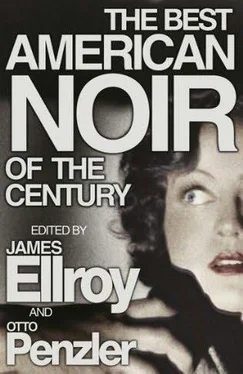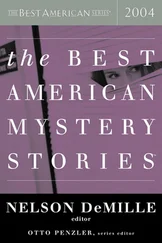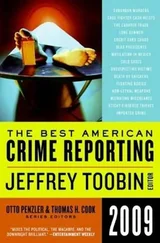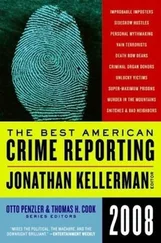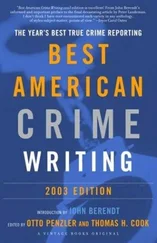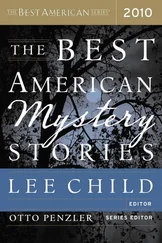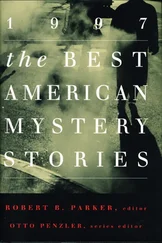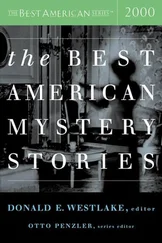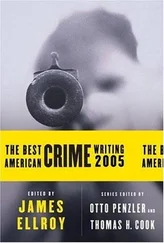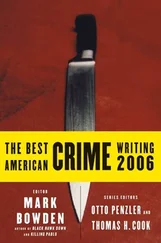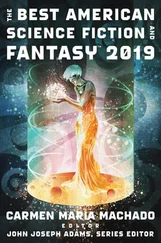Nelly had his face screwed into a wad, and his teeth showed between his lips.
“Never shot anything or anybody, did you, Nelly?” There was a snapping sound, and I jumped. It was only a stick breaking under Clyde’s foot as he moved nearer to the car. “You never shot a soul. Not a jack-rabbit or anything. You couldn’t.”
He was only ten feet away from Nelly and Nelly’s gun.
“You just pretended you could. But the guards in Oklahoma and Missouri didn’t know you the way I do. They hadn’t ever gone hunting with you, had they?”
He took another step forward. Another. Nelly was something out of a waxworks in a sideshow, watching him come. Then a vague suffusion of light began to show around them; a carload of deputies had spotted my car at the head of the lane; their headlamps came hurtling toward us.
“You shot telephones off of desks,” Clyde purred to Nelly, “and tires off of cars. You’ve been around and you’ve done a lot of shooting. But you never shot things that the blood ran out of…Now, you drop your gun, Nelly. Drop it on the ground. Gosh, I was crazy this afternoon. I shouldn’t have laid down when you told me to. I should have just stood there.”
Maybe he was right and maybe he was wrong, I don’t know. The car stopped and I heard men yell, “Look out, Sheriff!” They were ready with their machine guns, trying to hustle themselves into some position where they could spatter the daylights out of Nelly Tare without shooting Clyde Boston too. Clyde didn’t give them a chance to do it. He dove forward; he flung his arms around Nelly and crushed him to the ground.
Nelly cried, and I don’t like to think about it; sometimes I wake up in the night and think I hear him crying. My memory goes back to our haymow days and to the rats in the chicken pen — the rats that Nelly couldn’t shoot — and I remember the bloody cottontails dangling from Clyde’s belt.
Nelly cried, but not solely because he was captured and would never be free again. He wept because the world realized something he had tried to keep hidden, even from himself. When he was taken back into prison, he wore an expression of tragic perplexity. It must have been hideous for him to know that he, who had loved guns his whole life long, should at last be betrayed by them.
1945
DAY KEENE
NOTHING TO WORRY ABOUT
Day Keene, the pseudonym of Gunard Hjertstedt (1904-1969), was born on the south side of Chicago. As a young man he became active as an actor and playwright in repertory theater with such friends as Melvyn Douglas and Barton MacLane. When they decided to go to Hollywood, Keene instead opted to become a full-time writer, mainly for radio soap operas. He was the head writer for the wildly successful Little Orphan Annie, which premiered on NBCs Blue Network on April 6,1931, and ran for nearly thirteen years, as well as the mystery series Kitty Keene, Incorporated, about a beautiful female private eye with a showgirl past; it began on the NBC Red Network on September 13, 1937, and ran for four years. Keene then abandoned radio to write mostly crime and mystery stories for the pulps, then for the newly popular world of paperback originals, for which his dark, violent, and relentlessly fast-paced stories were perfectly suited, producing nearly fifty mysteries between 1949 and 1965. Among his best and most successful novels were his first, Framed in Guilt (1949), the recently reissued classic noir Home Is the Sailor (1952), Joy House (1954, filmed by MGM in 1964 and also released as The Love Cage, with Alain Delon, Jane Fonda, and Lola Albright), and Chautauqua (1960), written with Dwight Vincent, the pseudonym of mystery writer Dwight Babcock; it was filmed by MGM in 1969 and also released as The Trouble with Girls, starring Elvis Presley and Marlyn Mason.
“Nothing to Worry About” was first published in the August 1945 issue of Detective Tales.
If there were any letters of fire on Assistant State’s Attorney Brad Sorrel’s broad and distinguished brow, they were invisible to his fellow passengers in the lighted cabin of the Washington-Chicago plane, as it circled the Cicero Airport at fifteen minutes to midnight. The stewardess, appraising his broad shoulders, graying temples, and hearty laughter, considered the woman to whom he was returning very fortunate indeed. His seat mate had found him intelligent and sympathetic.
At no time during the flight, or during the hours preceding it, had there been anything in Sorrel’s voice or demeanor to which anyone could point and say, “I knew it at the time. He was nervous. He couldn’t concentrate. His conversation was forced. He talked and acted like a man about to kill his wife.”
It was no sudden decision on Sorrel’s part. He had considered killing Frances, often; only a firm respect for the law that he himself represented had deterred him. He had, in the name of the state, asked for, and been given, the lives of too many men to be careless with his own. Intolerable as his marital situation had become, it was preferable to facing a jury whom he had lost the right to challenge.
The no smoking and please fasten your seat belt panels over the door of the pilot’s compartment blinked on. The lights of the field rushed up to meet the plane.
This is it, Sorrel thought. In twenty minutes, thirty at the most, Frances will be dead. Poor soul.
His seat mate wound up the telling of the involved argument and verbal slug-fest in which he had just engaged with the Office of Price Administration. Sorrel gave him one-half of his mind, sympathizing hugely, assuring him he had been right, that it couldn’t last forever, and agreeing that it seemed that private business was headed for a boom.
The other half of his mind considered the thing that he had to do. It would not be pleasant. In his search for a solution to his problem, he had inspected, weighed, and judged the none-too-many means by which murder could be done. The alleged clever methods — accidental death, suicide, death by misadventure — he had rejected almost immediately. They left too many loopholes for failure; few of them ever succeeded. There was a reason. No matter how brilliant a killer might be, he was seldom, if ever, a match for the combined technical, executive, and judicial branches of the law.
Crime detection, trial, and judgment had become akin to an exact science.
The art of killing, the three Ms, means, method, motive, had changed little in the known history of man. To take a life, one still had to shoot, knife, drown, strike, strangle, or poison the party of the unwanted part. And, as with most basic refinements to the art of living, the first known method of murder used — that of striking the party to be removed with whatever object came first to hand —was still the most difficult of detection, providing of course that the party who did the striking could maintain a reasonable plea of being elsewhere at the time.
* * *
It was, after mature consideration, that method that Sorrel had chosen. He had even chosen his weapon, one of the heavy cut-glass candlesticks that stood on Frances’s dressing table.
“Murphy. J. P. Murphy is the name,” his seat mate identified himself. He shook Sorrel’s hand vigorously. “It’s been a pleasure to meet you, Prosecutor. And if you decide to enter the senatorial race, as I’ve seen hinted at in the papers, you can count on my vote as certain.”
Sorrel’s hearty laugh filled the plane. “Thanks. I’ll remember that, Murphy.”
His only luggage was his briefcase. The stewardess insisted on getting it down from the rack for him. He tucked a forbidden bill in the breast pocket of her uniform. “Nice trip.” He smiled. “And thanks.”
Читать дальше
Конец ознакомительного отрывка
Купить книгу
